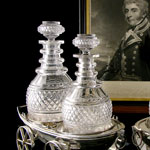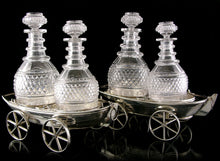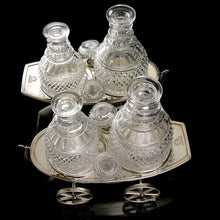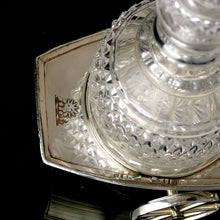Vice-Admiral Sir Henry Blackwood 1st Baronet, G.C.H., K.C.B. - ‘Jolly Boat’ Wine Trolleys, Circa 1810
Adding product to your cart
Length of each: 33cm (13in)
In the form of a pair of Old Sheffield plate (silver on copper) clinker-built rowing boats each set on a pair of detachable axles with spoked wheels, the interiors with two circular depressions for decanters and two for stoppers, rope-ring attachments to bows and engraved on the stern thwart with the armorial crest of ‘the sun rising from behind a cloud, all ppr.’ as granted to Rear-Admiral Sir Henry Blackwood (1770-1832) at the creation of his baronetcy (Blackwood of the Navy) in the baronetage of the United Kingdom on 23 July 1814; complete with a matched set of two large and two smaller Regency decanters.
Read more
Usage: Aboard ship Jolly Boat wine trolleys were dismounted from their wheeled carriages. It was customary at the table after pouring out wine or spirit from the decanter, to return it to the stand and push it along to the next officer. It is believed that the saying ‘to push the boat out’ has its origins in this old naval custom as the officer paying for the wine was the first to start the jolly boat off round the table.
The armorial engraving combined with the idiosyncratic form of the present wine trolleys indicates the ownership of Nelson’s most favoured frigate captain, Henry Blackwood, whose later career as Commander-in-Chief in the East Indies and Commander-in-Chief at the Nore provided ample opportunity for the use and display such appropriately themed tableware.
Prior to the first meeting between Nelson and Blackwood, the national hero was already a dedicated supporter and admirer of his subordinate’s vigilance, seamanship and willingness to close with the enemy. On the night of 30 March 1800 it was Blackwood in the small frigate Penelope that maintained the close pursuit of the 80-gun Guillaume Tell, the strongest French ship to survive the Battle of Nile, alternately pouring crippling broadsides into the vastly superior vessel’s stern quarters until larger British ships could catch up - a feat that later caused Nelson in communication with Blackwood to write ‘Is there a sympathy which ties men together in the bonds of friendship without having a personal knowledge of each other? If so (and I believe it was so to you), I was your friend and acquaintance before I saw you. Your conduct and character on the late glorious occasion stamps your fame beyond the reach of envy. It was like yourself; it was like the Penelope. Thanks; and say everything kind for me to your brave officers and men ...’
Blackwood was born in County Down, Ireland, the seventh son of Sir John Blackwood, 2nd Baronet of Killyleagh, and his wife Dorcas (Stevenson), 1st Baroness Dufferin and Clandeboye. He entered the navy as a volunteer 1781, serving in the Mediterranean, and on the Newfoundland station, steadily gaining the confidence of his superiors, and developing a flare for frigate operations. He twice turned down the command of a 74-gun ship-of-the-line for the special opportunities offered in frigate service. In 1805 he brought the news to London of the breakout of the French and Spanish fleets from Ferrol and their entrance into Cadiz, halting briefly at Merton in the early hours of the morning to inform Nelson, who went with him to the Admiralty, and received his final instructions to resume the command of the fleet without delay.
On the morning of Trafalgar, 21 October 1805, Blackwood was on board the Victory and received a freehand in commanding all the frigates in assisting any disabled ships. He was further given permission to make use of Nelson’s name in ordering any of the stern most line-of-battle ships to do what struck him as best. Blackwood together with Captain Hardy also witnessed the disregarded codicil to Nelson’s will - 'I leave Emma, Lady Hamilton therefore a legacy to my King and Country that they will give her an ample provision to maintain her Rank in Life.' It was not until afternoon with shot flying thickly over the flagship, that Blackwood was finally ordered by Nelson back to his frigate Euralyus with the words 'God bless you, Blackwood, I shall never speak to you again.' Immediately after the battle Collingwood hoisted his flag in Blackwood’s ship, but after ten days removed it to the Queen, and the Euryalus was sent home with despatches and with the captured French admiral Villeneuve. Blackwood landed at Falmouth and was one of the first messengers to use the Trafalgar Way to deliver his dispatches to the Admiralty in London. He was thus in England at the time of Lord Nelson's funeral (8 January 1806), on which occasion he acted as train-bearer of the chief mourner, Sir Peter Parker, the aged admiral of the fleet.








